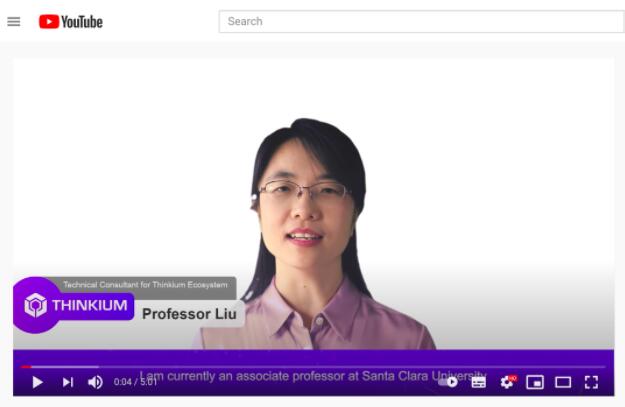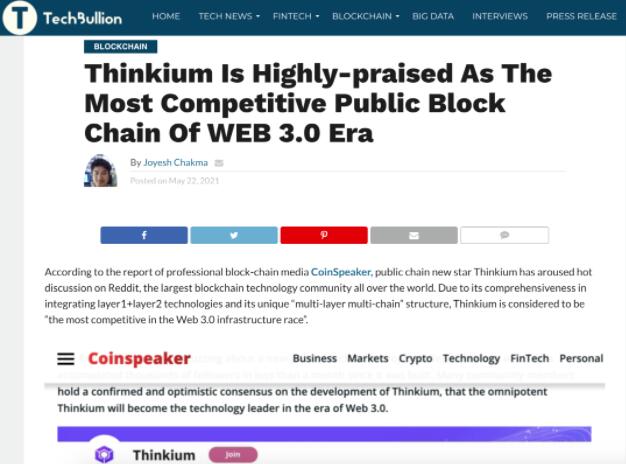太空猫公链的九大技术创新在YouTube火了!
2021年6月1日,一段关于Thinkium(太空猫公链) 的九大技术创新视频在YouTube上广为流传!

视频中的刘教授,是美国圣塔克拉拉大学的副教授,研究领域包括新兴应用(例如物联网,区块链和在线社交媒体)的可信赖计算和网络安全,曾在著名期刊和同行评审会议上,发表过60多篇学术论文,并获得众多学术奖项。
(https://www.scu.edu/engineering/faculty/liu-yuhong/)
本次,刘教授作为Thinkium(太空猫公链) 生态的技术顾问,为我们讲解了太空猫公链的九大技术创新。
我们将刘教授的技术解读进行了翻译,让各位小伙伴能够进一步了解太空猫公链的技术优势!
翻译内容如下,Enjoy~
感谢大家参加今天的讨论。我叫刘宇宏,目前是圣塔克拉拉大学的副教授。同时,我也是Thinkium的技术顾问。
今天,我想简要地介绍一下Thinkium几大关键技术创新。
作为公链网络的基础设施,Thinkium可以承载互联网级大规模应用的落地发展,桥接物理世界和数字世界,开启Web 3.0时代。
今天,我将重点解读Thinkium的九大技术创新。
第一项创新是Thinkium独特的分层多链结构。理论上,它可以通过将子链与主链分离、子链继承父链的属性、链内分片和子链互通实现性能无限扩展。
第二项创新是Aplati树。它是一种扁平树链结构,通过实现两种不同类型的链层对逻辑结构进行管理。一条是子链层,另一条是主链层。从逻辑上讲,主链和子链都可以充当父链,创建任意数量的子链,共享相关业务。实际上,父链和子链也可以看作是独立的链,它们的关系只在主链上记录和维持,这使得管理起来,非常容易。
第三项创新是四层系统架构,其中每个特定层都可以专注于自己的逻辑任务和相应的共识机制。这样的设计能够方便系统将来的可扩展和升级。
第四项创新是基于Actor的并行模型。该模型可实现高吞吐量,高复杂性的交易处理。特别的是,Actor并行模型避免了传统并行模型中不同锁定机制导致的低效率,允许异步消息执行复杂的逻辑。
第五项创新:Thinkium支持双币生态系统。特别的是,Thinkium支持子链开发自己的数字货币,建立其独立的行业生态。
第六项创新:Thinkium支持早期的小型企业以最低成本搭建独立单链,这些链可以针对自己的业务场景进行定制。一旦成熟,这些独立单链也可以通过支持接口,顺畅地接回Thinkium系统里。
第七项创新:Thinkium可以有效平衡相关业务的保密性与业务流程的开放性。特别的是,Thinkium的设计能够让公链和联盟链之间相互兼容。如此一来,一些敏感性业务可以只部署在可信的、需要许可的联盟链上。而其他对外开放的业务可以部署在无需许可的公链上,实现更大规模的交易。
第八项创新:结合结构性和非结构性的P2P网络,Thinkium能够同时保持系统的效率和稳定性。
最后一项创新:Thinkium 可以通过Themis网络建立一个公平的社区环境,一个基于全网用户的治理机制。特别的是,(每个用户投票都有一个相应的特定“提议”),这些提议是最终要执行的交易,而这些交易执行时,不是验证签名,而是通过对公投结果的确认进行验证。对于用户而言,他们可以通过多个不同的方式参与管理过程,例如通过基金会,委员会,DSO,DAO或普通账户。
这些就是我今天重点解读的九大技术创新。谢谢大家。
Thinkium(太空猫公链)生态技术顾问刘教授,在短短几分钟内为我们简要解读了太空猫公链的九大技术创新。
不久前,太空猫公链的九大创新技术也在海外Reddit社区引发热烈讨论,海外各大知名媒体Coinspeaker、Techbullion也对此进行了报道。

针对太空猫公链这九大技术创新,未来太空猫星海也会进行深入的解读。各位小伙伴可以敬请期待。
我们在文末放上了刘教授英文版的技术解读,以供各位小伙伴赏阅~
英文版:
Thank you all for attending the talk today. My name is Yuhong Liu. I am currently an associate professor at Santa Clara University. And I’m also serving as technical consultant for Thinkium.
Today, we’d like to briefly go through the key technical innovations of Thinkium, which is a public blockchain infrastructure that aims to facilitate Internet level large-scale applications and bridge the physical and the digital world to launch the era of Web 3.0.
So in particular, we would like to highlight nine innovations today.
The first innovation is its unique design of a multi-layer multi-chain structure,which can theoretically achieve unlimited scalability through the separation of subchains from the main chain, inheritance of child-chains from their parent chains, intra-chain sharding, and cross-chain communications.
The second innovation is the Aplati tree, which is a flat tree structure that enables unlimited logical layers through the implementation of only two different types of chains. One is the subchain. The other one is the main chain. Logically, both the main chains and the subchain can serve as a parent chain to create arbitrary number of child-chains to share their related businesses. Well, physically, the parent and child-chains can be viewed as independent chains, with their relationship only recorded and maintained only on the main chain,which makes management very easy.
The third innovation is a four-layer stack architecture, where each specific layer can focus on its own logic tasks and corresponding consensus mechanism. Such design makes it very easy and flexible for future system extension and upgrade.
The fourth innovation is the Actor-based parallel processing model, which enables high throughput and high complex transaction processing. In particular, the Actor-based model allows asynchronous messages for the execution of complex logic and avoids low-efficiencies caused by different locking mechanisms in conventional parallel models.
The fifth innovation is that Thinkium also supports its dual-coin ecosystem. In particular, Thinkium supports subchains to develop their own coins and therefore the corresponding independent eco-systems.
Number six. Thinkium also supports that the early-stage small businesses can develop their own low-cost, independent single-chains, which can be customized for their own business scenarios.Once mature, those independent single-chains can also be smoothly linked backed to the Thinkium system through some supported interfaces.
Number seven, Thinkium can effectively balance the tradeoff between the business confidentiality and the open business flow. In particular, the design of Thinkium makes it compatible with both permissionless blockchains and permission-based blockchains so that sensitive businesses can be deployed only on those more trustworthy permission-based blockchains,while other open businesses can be deployed on permissionless blockchains to enable more large-scale transactions.
The next innovation is that Thinkium can also effectively balance the tradeoff between system efficiency and stability by integrating both structural and non-structural P2P networks.
Last but not least, a fair community environment can also be established through Themis network, which is a management mechanism to enable votes from all users. In particular, those proposals can be submitted as an executable transaction, which is then verified not through signatures, but through the validation of the public votes. And for users, they can also participate in the management process through the multiple different formats, for example through foundations , the committees, DSO, DAO or just through their regular user accounts.
So these are the nine key innovations we would like to highlight today.
Thank you all.








